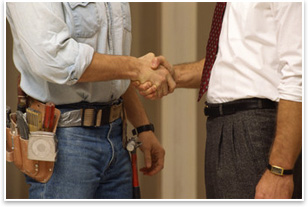
Best Practices Summary:
Ah, remember the project that went so well? You know, the one where the contractor didn’t send so many RFIs, and the owner was quick about making decisions. It was one of those projects where everyone could almost relax. No surprise attacks. No hidden agendas. What a project! You have to wonder what made things go so well. To read the full text of “The Power of One,” click here. It appeared to be just another project like the rest of them. Oh, yeah, we had problems, but they were all solved quickly; and there were no claims afterwards. The contractor laid out their work in spite of our original conflicting dimensions. As soon as everyone found a problem, the designers and contractor jumped in and revised their work without any delays or additional charges, and the contractor even gave us their corrected layout dimensions to check against our drawings. And we certainly didn’t mind helping the contractor when they installed that pier in the wrong location. It didn’t take much time for our structural engineer to come up with a solution that would transfer the loads. Anyway, by then we would have done about anything to help those guys. After all, they had done so much to help us.
The full text of this article explores those project experiences that have few problems even among many challenges. We will examine the project team and the correlation of how beneficial interaction affects the ultimate outcome. We will examine how the team working together produces a special power, the power of one initiative by multiple players to achieve success. And then
Remember the facts of life and guide yourself by them. We addressed the merits of the cool and collected approach in our October 2005 article in AIArchitect entitled, “Zen, and the Art of Construction Contract Administration.” Remember that the friendly and helpful approach will be received more gracefully than by ringing the doorbell with a hammer. On the other hand, if it isn’t meant to happen, then so be it, you don’t have to stand idly and be punched in the nose. Yet success and fulfillment are important ambitions … stay after them. Don’t give up trying to foster a team that acts as one. This is a human desire that exists in almost everyone. Every professional wants to work on a project that flows smoothly and is gratifying. Almost everyone has the same aspirations and goals. So as you prepare your preconstruction conference agenda and think about how you will attempt to be the catalyst for bringing occasionally adversarial players together as a cohesive and effective team, don’t forget to be careful out there. To read the full text of “The Power of One,” click here. |
||
Copyright 2007 The American Institute of Architects. All rights reserved. Home Page |
||
This series will continue next month in AIArchitect when Grant and Jim will continue to explore the stimulating aspects of our practice. If you would like to ask Jim and Grant a risk- or project-management question or request them to address a particular topic, contact them through AIArchitect.
James B. Atkins, FAIA, is a principal with HKS Architects. He serves on the AIA Risk Management Committee and is chairman of The Architect’s Handbook of Professional Practice, 14th edition Revision Task Group.
Grant A. Simpson, FAIA, has served as a project delivery leader for several international firms where his responsibilities included construction documentation, project management, and loss prevention activities. He serves on the AIA Practice Management Advisory Group.
This article is intended for general information purposes only and does not constitute legal advice. The reader should consult with legal counsel to determine how laws, suggestions, and illustrations apply to specific situations.

 It was as if a higher power eschewed strife and wanted us to succeed. Why was this project so different from the rest? Absent was the overt criticism normally present among the parties. Gone was the anticipated weekly berating in the owner/architect/contractor meetings when architects normally are publicly castigated for alleged late submittals or RFI responses. The atmosphere was one of cooperation and teamwork; owner, architect, and contractor working with a common purpose toward a common goal.
It was as if a higher power eschewed strife and wanted us to succeed. Why was this project so different from the rest? Absent was the overt criticism normally present among the parties. Gone was the anticipated weekly berating in the owner/architect/contractor meetings when architects normally are publicly castigated for alleged late submittals or RFI responses. The atmosphere was one of cooperation and teamwork; owner, architect, and contractor working with a common purpose toward a common goal. So how are you going to achieve this the next time around? How are you going to have that “special” project that seems to have no problems that can’t be solved? It takes preparation from the onset, and it may not happen if others on the project team do not share your goals of accomplishment, fulfillment, and yes, profit. But it will not likely occur if you do not attempt to make it happen.
So how are you going to achieve this the next time around? How are you going to have that “special” project that seems to have no problems that can’t be solved? It takes preparation from the onset, and it may not happen if others on the project team do not share your goals of accomplishment, fulfillment, and yes, profit. But it will not likely occur if you do not attempt to make it happen.